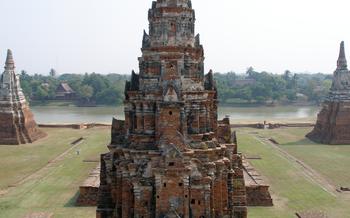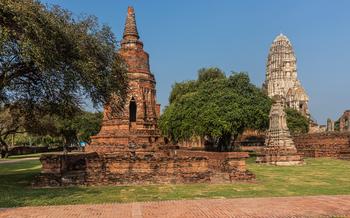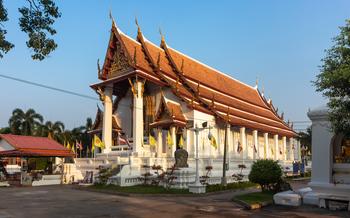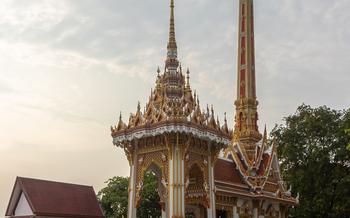
Wat Khae
- Historical Significance
- Main Attractions
- Visiting Hours and Admission
- Getting There
- Exploring the Temple Grounds
- Unique Features
- Local Culture and Traditions
- Photography and Videography
- Accommodation and Dining Options
- Insider Tip:
- Nearby Attractions
- Wat Khae's Role in Thai Buddhism
- Volunteer Opportunities
- Local Festivals and Events
- Sustainable Tourism
- Insider Tip
Historical Significance
Wat Khae holds immense historical and cultural significance in Thailand. Founded in the 16th century, it has served as a prominent religious center for centuries. Legends attribute its establishment to a revered monk named Luang Pu Thong, who is believed to have possessed supernatural powers. The temple's reputation grew as a place of worship and spiritual retreat, attracting devotees from across the region.
Over time, Wat Khae underwent several renovations and expansions, blending architectural influences from different eras. Its unique design showcases a fusion of traditional Thai and Khmer styles, making it a treasure trove for history and architecture enthusiasts. The temple's well-preserved murals and sculptures narrate significant episodes from Buddhist mythology, offering a glimpse into Thailand's rich cultural heritage.
Main Attractions
Wat Khae boasts a treasure trove of impressive Buddha images, murals, and other notable features that captivate visitors. The temple's main Buddha image, known as Luang Pho To, is a majestic golden statue that exudes an aura of serenity and reverence. It is housed in the temple's ordination hall, which is adorned with intricate murals depicting scenes from the life of Buddha and Buddhist cosmology.
The viharn, or assembly hall, is another architectural marvel. Its interior features a series of stunning murals that narrate the Jataka tales, stories of Buddha's previous lives. These vibrant murals showcase the temple's artistic prowess and provide visitors with a glimpse into Buddhist teachings and beliefs.
The temple's chedi, or stupa, is a towering structure that symbolizes the Buddha's victory over worldly desires and the attainment of enlightenment. Its graceful form and intricate design make it a focal point of the temple grounds and a symbol of Wat Khae's spiritual significance.
Wat Khae is also renowned for its collection of amulets and other holy objects. These sacred items are believed to possess protective powers and bring good fortune to their owners. Many visitors come to the temple to purchase amulets as a way to connect with the temple's spiritual energy and seek blessings for themselves and their loved ones.
Visiting Hours and Admission
Wat Khae welcomes visitors from all over the world, offering a unique opportunity to explore its rich history and cultural significance. The temple is open to the public daily, and visitors are encouraged to come and experience its serene atmosphere and awe-inspiring architecture.
Visiting Hours: - Monday to Sunday: 8:00 AM - 5:00 PM
Admission Fees: - Entrance to Wat Khae is free of charge. However, donations are welcome and greatly appreciated to support the temple's upkeep and preservation.
Special Days and Events: - During special days and events, such as Buddhist holidays or festivals, Wat Khae may have extended visiting hours or different admission policies. It is advisable to check with the temple in advance to confirm the specific arrangements for these occasions.
Dress Code and Etiquette: - Visitors are expected to dress respectfully when visiting Wat Khae. Modest attire that covers the shoulders and knees is recommended. Avoid wearing shorts, tank tops, or revealing clothing. - Please be mindful of your behavior and maintain silence while exploring the temple grounds. Refrain from loud talking or disruptive activities that may disturb the tranquility of the sacred space.
Getting There
Wat Khae is situated approximately 100 kilometers northeast of Bangkok, in the Saraburi province of Thailand. The journey from Bangkok to Wat Khae by car takes about 2 hours, depending on traffic conditions. Visitors can also take a bus from Bangkok to Saraburi, which takes about 3 hours, followed by a short taxi or tuk-tuk ride to the temple.
For those traveling from other parts of Thailand, there are several options available. Trains from major cities such as Chiang Mai and Hat Yai stop at Saraburi station, from where visitors can take a taxi or tuk-tuk to the temple. Alternatively, visitors can take a bus from various cities to Saraburi, and then transfer to a local bus or taxi to reach Wat Khae.
Once in Saraburi, visitors can easily find their way to Wat Khae using a map or GPS navigation. The temple is well-signposted, and there are plenty of local people who can provide directions if needed.
Exploring the Temple Grounds
Wat Khae's sprawling grounds are a testament to its rich history and religious significance. Visitors can embark on a journey of discovery as they explore the temple's various structures and features. The main temple building, known as the ubosot, is a sight to behold, with its intricate carvings and gleaming golden chedi. Inside, visitors can marvel at the impressive Buddha image, which radiates serenity and peace.
The viharn, or assembly hall, is another must-see attraction at Wat Khae. This spacious hall is adorned with colorful murals depicting scenes from the life of Buddha and other Buddhist stories. The murals are a testament to the artistic skills of the temple's artisans, and they offer visitors a glimpse into the rich cultural heritage of Thailand.
Surrounding the main temple building are several stupas, or bell-shaped structures, which contain the ashes of deceased monks and other important figures. These stupas are a reminder of the temple's role as a center of spiritual devotion and a place of reverence for the departed.
Visitors can also explore the temple's serene gardens, which feature a variety of tropical plants, flowers, and trees. The gardens provide a tranquil oasis amidst the hustle and bustle of the city, and they offer visitors a chance to relax and reflect on the temple's sacred atmosphere.
Unique Features
Wat Khae stands out among Thailand's countless temples for its exceptional collection of ancient artifacts, which captivates visitors with their historical and cultural significance.
-
The temple houses a remarkable collection of Buddha images, each with its own unique style and iconography. These images span various periods of Thai history, providing a glimpse into the evolution of Buddhist art.
-
Wat Khae also boasts an impressive collection of ancient manuscripts and scriptures, which are carefully preserved and studied by scholars and monks. These documents shed light on the temple's rich history and the development of Buddhist teachings in Thailand.
-
In addition, the temple is home to a number of intricate sculptures and carvings that adorn its walls and pillars. These artworks depict scenes from Buddhist mythology and folklore, adding to the temple's visual appeal and storytelling charm.
-
Wat Khae's unique features extend beyond its physical attributes. The temple is renowned as a center for meditation and spiritual retreats, attracting practitioners from around the world who seek inner peace and spiritual enlightenment.
Local Culture and Traditions
Wat Khae is deeply intertwined with the local culture and traditions of Saraburi. The temple serves as a spiritual and cultural center for the community, hosting various ceremonies and festivals throughout the year. One of the most significant events is the annual temple fair, which attracts thousands of visitors from neighboring provinces. During the fair, the temple grounds come alive with colorful decorations, food stalls, and traditional performances. Visitors can witness merit-making ceremonies, listen to monks' teachings, and participate in cultural activities such as shadow puppet shows and Thai classical dance demonstrations. The temple's amulets and holy objects are highly revered by local residents, who believe in their protective and auspicious powers. Many locals visit the temple to receive blessings from the monks and to purchase amulets as tokens of good luck and prosperity.
Photography and Videography
At Wat Khae, photography and videography are generally permitted, allowing visitors to capture the temple's beauty and sacred atmosphere. However, it is important to respect the temple's sacred nature and follow the established guidelines. Visitors should refrain from using flash photography, as it can be disruptive to other visitors and potentially damage the temple's artifacts. Tripods and other photography equipment should be used discreetly to avoid obstructing pathways or disturbing other visitors.
When taking photos or videos, visitors should focus on capturing the temple's architectural details, stunning Buddha images, and serene surroundings. It is recommended to explore the temple grounds thoroughly to find unique angles and compositions. Visitors should also be mindful of the privacy of other visitors and avoid taking photos or videos that may be intrusive or disrespectful.
Overall, Wat Khae welcomes visitors to document their experiences through photography and videography, as long as they adhere to the temple's guidelines and show respect for the sacredness of the site.
Accommodation and Dining Options
Saraburi offers a range of accommodation options for visitors who wish to extend their stay and explore the city's many attractions. From budget-friendly guesthouses to comfortable hotels, there's something to suit every taste and budget.
For a truly immersive experience, consider staying at a traditional Thai homestay. This is a great way to connect with local families and gain insights into Thai culture and daily life. Homestays typically offer simple but comfortable accommodations and delicious home-cooked meals.
When it comes to dining, Saraburi has a diverse culinary scene that caters to all palates. From street food stalls serving up mouthwatering snacks to upscale restaurants offering fine dining experiences, there's something for everyone to enjoy.
Be sure to sample some of the local specialties, such as grilled pork skewers, spicy papaya salad, and boat noodles. For a unique dining experience, head to the floating market where you can savor delicious Thai dishes while cruising along the river.
Insider Tip:
For a taste of authentic Thai street food, visit the night market near Wat Khae. Here you'll find a variety of food stalls selling everything from grilled meats to fresh seafood and tropical fruits. It's a great place to sample different Thai delicacies and soak up the lively atmosphere.
Nearby Attractions
Wat Khae's location in Saraburi makes it an ideal starting point for exploring other attractions in the area. Just a short drive away, visitors can immerse themselves in the ancient history of Thailand at the Saraburi National Museum, which houses a collection of artifacts from the prehistoric era to the present day.
Nature enthusiasts will delight in exploring the nearby Khao Yai National Park, a UNESCO World Heritage Site renowned for its stunning scenery, diverse wildlife, and hiking trails. Visitors can spot elephants, gibbons, and a variety of bird species as they traverse the park's lush forests and cascading waterfalls.
For a unique cultural experience, head to the nearby village of Ban Khao Din, known for its traditional Thai puppet theater performances. Visitors can witness the intricate craftsmanship of the puppets and enjoy lively shows that bring Thai folklore to life.
A trip to Saraburi is not complete without sampling the local cuisine. Visitors can indulge in delicious Thai dishes at the many restaurants and street food stalls in the city. Must-try specialties include "Khao Soi Saraburi," a noodle dish with a rich coconut curry broth, and "Sai krok Isan," a spicy fermented sausage.
Wat Khae's Role in Thai Buddhism
Wat Khae holds a significant position within the framework of Thai Buddhism, serving as a bastion of preserving and promoting the sacred teachings and practices of the faith. Throughout its illustrious history, the temple has been instrumental in disseminating the principles of Buddhism, not only within Thailand but also across the vast tapestry of Southeast Asia. The temple's unwavering commitment to upholding Buddhist traditions has earned it a revered reputation, attracting devotees and pilgrims from far and wide who seek spiritual enlightenment and guidance.
Over the centuries, Wat Khae has been blessed with the presence of numerous renowned monks and teachers who have dedicated their lives to spreading the wisdom of Buddhism. These erudite individuals have played a pivotal role in shaping the temple's identity and solidifying its reputation as a center of Buddhist scholarship and learning. Their profound teachings have left an indelible mark on the hearts and minds of countless disciples, inspiring them to embrace the path of righteousness and compassion.
Volunteer Opportunities
Wat Khae offers a unique opportunity for visitors to give back to the community through volunteer work. The temple welcomes volunteers from all backgrounds and skill sets who are interested in contributing to its ongoing projects and initiatives.
Volunteers can participate in various activities, such as teaching English to local children, assisting with temple maintenance and upkeep, or helping with community development projects. The temple also encourages volunteers to share their skills and talents, such as art, music, or sports, to enrich the lives of the local community.
Volunteering at Wat Khae is a rewarding experience that allows visitors to immerse themselves in Thai culture, make meaningful connections with the local people, and contribute to the preservation and promotion of the temple's heritage. To inquire about volunteer opportunities, visitors can contact the temple directly or reach out to local organizations that facilitate volunteer programs in Saraburi.
Local Festivals and Events
Wat Khae is renowned for its vibrant festivals and events that attract devotees and visitors from near and far. The temple's annual "Phra Phrom Phithi" ceremony, held in February or March, is a grand celebration honoring the sacred Phra Phrom statue. During this festival, elaborate processions, chanting, and offerings are performed to pay homage to the revered deity.
Another highlight is the "Songkran Festival," which takes place in April and marks the Thai New Year. Wat Khae becomes a hub of activity during this time, with locals and tourists alike participating in water-splashing rituals, merit-making ceremonies, and traditional performances. Visitors can immerse themselves in the lively atmosphere, enjoy delicious local food, and witness the colorful processions that fill the temple grounds.
In addition, Wat Khae hosts regular meditation retreats, Dharma talks, and chanting sessions throughout the year. These events offer visitors an opportunity to delve deeper into Buddhist teachings, connect with fellow practitioners, and find inner peace and tranquility.
Sustainable Tourism
Wat Khae is committed to preserving its natural and cultural heritage while promoting sustainable tourism practices. Visitors are encouraged to respect the temple's environment by minimizing their ecological footprint. The temple has implemented several initiatives to promote sustainability, such as using renewable energy sources, reducing waste, and conserving water. Visitors can contribute to these efforts by being mindful of their resource consumption and respecting the temple's rules and regulations. By embracing sustainable tourism, visitors can help protect Wat Khae's sacred beauty and ensure its preservation for future generations.
Insider Tip
-
For an unforgettable experience, plan your visit to Wat Khae during the annual temple fair, which usually takes place in February or March. Immerse yourself in the vibrant atmosphere as locals and visitors come together to celebrate with traditional performances, delicious food stalls, and colorful processions. It's a fantastic opportunity to witness the temple's cultural significance firsthand.
-
Discover the hidden gem of Wat Khae's tranquil meditation garden, nestled amidst lush greenery behind the main temple complex. Find a secluded spot to sit in peaceful contemplation, surrounded by the gentle sounds of nature, and allow the serenity of the surroundings to wash away your worries.
-
Capture the ethereal beauty of Wat Khae at sunrise, when the first rays of light illuminate the temple's spires and cast a golden glow over the grounds. Arrive early to witness the monks' morning alms-giving ceremony, where locals offer food to the resident monks as an act of merit. It's a sacred ritual that provides a glimpse into the daily life of the temple community.





